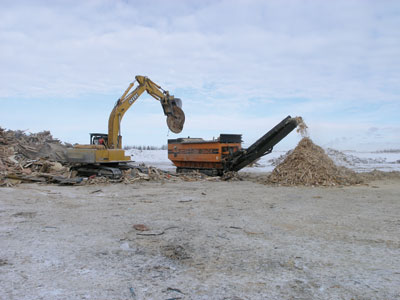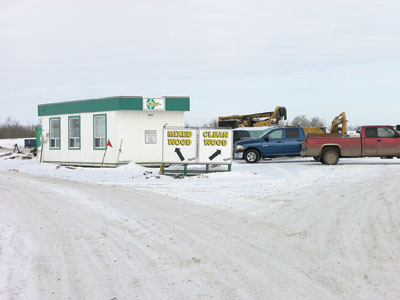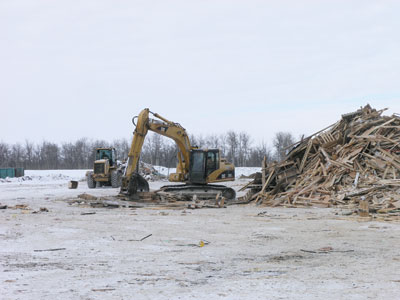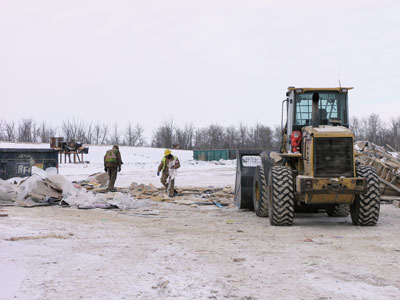
Bountiful landfill: Alberta company puts wood waste to good use
April 1, 2011
By
Heather Hager
The recent recession was unfavourable for many companies, but the BioFuels Recycling Centre wasn’t one of them.
 The new shredder has allowed Biofuels to serve a new market: large wooden spools that are held together by metal rods. The site will soon see two new additions: an excavator and a loader, both Deere, from Brandt Tractor.
The new shredder has allowed Biofuels to serve a new market: large wooden spools that are held together by metal rods. The site will soon see two new additions: an excavator and a loader, both Deere, from Brandt Tractor. The recent recession was unfavourable for many companies, but the BioFuels Recycling Centre wasn’t one of them. It actually saw an increase in business over the past year, says Brian Perrault, site manager for the construction and demolition waste recovery facility. He suspects that’s because of the substantially lower tipping fees for clean wood waste that can be diverted from the landfill and put to good use.
And that’s exactly what BioFuels is doing. Located at the Northlands Landfill site just west of Edmonton, Alberta, the six employees sort, shred, and recycle wood materials dropped off by various disposal companies and small contractors.
“We have an agreement with Northlands Landfill,” explains Perrault. “They send us the clean wood and a mixed product that is up to 50% mixed. We divert it from going into the pits.”

The mixed material, which can contain plastics, paper, cardboard, steel, drywall, insulation, or other materials, is processed separately from the clean wood. It’s first spread out in a sorting area, where a small Cat excavator, equipped with a generator and magnet, removes the steel.
The remaining material is sorted on the ground by hand. Steel and other materials such as aluminium and drywall are sent elsewhere for reuse and recycling, generating some revenue. Just about the only material that can’t be recycled is insulation, which goes to the on-site landfill, says Perrault.
Clean, pre-sorted wood is the preferred supply, however. “If they bring in clean wood, they get quite a cost reduction on the tipping fee coming in the gate,” Perrault notes. “So it makes it look a lot more attractive to bring clean wood than mixed wood because it’s so labour intensive to sort and separate that mixed material.”
Once sorted and piled, a larger Deere excavator and a Doppstadt shredder move around the site to shred the wood, keeping it in separate clean and mixed-source piles that are destined for different uses. A Cat front-end loader places the shredded wood in 50-foot walking-floor trailers for transport to its final destination.
Multiple wood streams
The main purpose of the BioFuels facility is to supply fuel to the Dapp Power plant. Both BioFuels and Dapp are owned by Fortistar, a New York-based renewable energy company that owns more than 50 landfill gas power plants across the United States. Dapp is one of two 100% biomass-fired electricity generating stations the company owns in Canada, and it produces power for the Alberta grid.

Perrault estimates that about 97 per cent of BioFuels’ shredded wood product, mostly from the mixed source, is trucked approximately 100 km north to the power plant. He says that amounts to 35,000 to 40,000 tonnes/year
diverted from landfill. “Our goal this year is to break 40,000 tonnes,” he says. “Every year it’s a gradual increase. We’re doing something that a lot of people never thought would ever happen, to get that kind of volume away from a landfill.”
On average, BioFuels ships out five or six 25- to 28-tonne truckloads each day, but that varies by season. The sorting yard is busier in summer, when one or two additional employees join the team to keep up with the processing demand.
The clean waste wood is sold for various uses, including landscape mulch, animal bedding, and oilfield remediation. In a new project just begun in 2011, a compost plant is purchasing most of the clean, shredded product for mixing with its other organics.
BioFuels also bids for custom shredding jobs off-site. “We’re very portable,” says Perrault. “We just move our site to another site and truck the shredded product from there. It saves the company from transporting it here.” For example, they’ve done custom shredding at pallet manufacturing facilities and gas plant construction sites.
Tools of the trade
Up until 2010, the company used a high-speed grinder to process the wood debris. However, Perrault says they found that it limited the types of mixed materials they could process without stopping for frequent maintenance and repairs. “The grinder did not like steel,” he notes. Last year, after seeing a demonstration of the Doppstadt shredder’s capabilities, Perrault purchased one to replace the grinder.

“That opens up a new market for us,” he explains. “We now recycle wooden spools, where before, there was nothing you could do with them because there’s metal in them. That’s a huge market all across Canada, and our volumes are increasing from when we first started with the spools.” He says the shredder tears the spools apart and has a magnet that removes the steel to a separate pile.
That capability also makes the initial processing less labour intensive. “Our amount of sorting now is way faster, being able to put the product into that new machine as opposed to the grinder, where you were basically picking up every single tiny piece of wood to make sure that no steel went in,” says Michelle Dixon, who’s been the ground supervisor and heavy equipment operator at the site for three years. “Now, if we happen to miss a piece or two, the machine just spits it right out.”
All in all, the wood recycling centre is a fairly simple operation requiring a few key pieces of equipment. Most of the time, the shredder runs six to eight hours every day, five days a week, says Perrault. That means the material turnover rate is rapid, with little need for extensive on-site storage. The wood fibre is sorted, shredded, and trucked out to its final destination almost as fast as it arrives.
Print this page